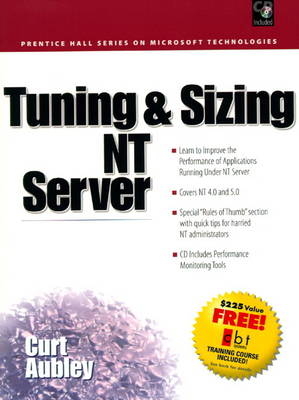
Sizing and Tuning of Windows NT
Prentice Hall (Verlag)
978-0-13-095388-9 (ISBN)
- Titel ist leider vergriffen;
keine Neuauflage - Artikel merken
Windows 2000 Server can drastically reduce the cost of enterprise networking -- but only if your servers are properly configured. In this book, Windows 2000 expert Curt Aubley walks you through every aspect of setting up Windows 2000 Server for your custom environment, stress-testing it to evaluate performance, and sizing hardware to achieve maximum value. Aubley doesn't just show you how to make your current Windows 2000 Server-based solutions run quickly and cost-effectively: he covers the "whys" you'll need to address any Win2K performance challenges. You'll find specific, detailed recommendations for sizing and tuning both Windows 2000 software and hardware, including CPU, memory, disk subsystem, network, and other potential bottlenecks. Aubley presents detailed coverage for maximizing performance and scalability in each leading Windows 2000 server application, including: optimizing file servers, IIS 5-based web servers, database servers running SQL Server 7 or 2000, messaging servers running Exchange 5.5 or 2000, backup systems, and domain controllers. He also offers insight into the performance overhead associated with security on Windows 2000 Servers.
The book includes practical "Rules of Thumb" for identifying bottlenecks; management scripts for tracking performance and availability, and much more.
Curt Aubley is currently Chief Technology Officer (CTO) and Chief Information Officer (CIO) for the OAO Corporation. His articles appear in leading trade magazines, including SunWorld and Windows 2000. Aubley holds MCSE certification and has spent over thirteen years working with UNIX and Windows NT/2000 operating systems in eCommerce, performance, and security roles. He has spent extensive time benchmarking, troubleshooting, testing, optimizing and sizing solutions for organizations including Raytheon, AT&T, NCR, and Neal Nelson & Associates, a leading benchmarking firm.
Preface.
Audience.
Organization.
Acknowledgments.
1. Instant Rules of Thumb for Tuning and Sizing NT Server.
Performance Statistics Gathering: Start the Logs. Key Points to Remember When Using Performance Monitor.
Three Action Items to Complete. Determining Which Applications (Processes) Are Running Under NT Server. NT Server Bottleneck Detection Strategy. Tuning Memory Resources. Tuning Disk Resources. Appropriate Use of RAID. Tuning RAID Controller Cache. Tuning NT Server's Network Subsystem. Tuning CPU Resources. Sizing and Tuning Specific Server Implementations. Microsoft Exchange. Sizing Rules of Thumb. Sizing Disk Subsystem Performance. Sizing the CPU(s). Sizing Memory Requirements. Summary.
2. Tuning Strategies and Measurement Gathering.
Goals for Tuning NT Server. The Big Picture: Understand the Entire Architecture. Tuning Strategy. Developing a Baseline. Free and Commercially Available Tools for Baseline Development. Performance Monitor. Alert Mode and Monitor Service. Additional Perfmon and Monitor Service Techniques. Putting It All Together: The Environment. Summary.
3. Capacity Sizing.
Goals of Sizing. Reality of Sizing. Sizing Methodology. Benchmarks Are Your Friends. Where Do Historical Baselines Fit in the Sizing Methodology?. How Server Architecture Relationships Affect Server Configurations. Properly Sizing Memory. Server I/O Relationships. Sizing Summary.
4. NT Server and CPU Performance.
CPU. Planning Around CPU and System Bus Bottlenecks. Comparing CPU Performance. Look at the Big Picture for CPU Selection. NT Server and the CPU. Affinity. Detecting CPU Bottlenecks. Applying Artful CPU Tuning. Interrupt Driven CPU Bottlenecks. Sizing CPU Subsystems. Tuning Strategies for Removing CPU Bottlenecks. Helping NT Server to Control Process Priorities . Thinking Outside of the Box. Summary.
5. NT Server and Memory Performance.
Memory Technology Review. NT Server's File System Cache. NT Server Memory Strategies. Comparing NT Server Memory Management Strategies. Understanding Your Environment Equals Improved Performance. Sizing the Memory Subsystem. Detecting Memory Bottlenecks. Tuning Memory Resources. The Last Resort: Purchase More RAM. Thinking Outside of the Box. Summary.
6. NT Server and Disk Subsystem Performance.
Disk Subsystem Technology: Following the Data. SCSI Bus Technology from a Practical Perspective. I/O Bus Technology. Redundant Array of Inexpensive Disks (RAID). Scaling RAID Arrays. How NT Server Uses the Disk Subsystem. NT Server Device Drivers. Sizing NT Server's Disk I/O. Subsystem. Disk Storage Capacity versus Disk Performance Capacity. Detecting Disk I/O Bottlenecks 246 Detecting the Obvious Disk Subsystem Bottleneck. General NT Server Tuning Considerations and Recommendations. SCSI Channel, Disk Subsystem, and Host Bus Adapter Tuning Considerations. RAID Tuning Considerations. Thinking Outside of the Box. Summary.
7. NT Server and Network Performance.
Relative Network Throughputs. NT Server Networking Performance Considerations. Sizing the NT Server Network Subsystem. Detecting NT Server Network Bottlenecks. Adding Networking Related Counters to Perfmon. Tuning Network Resources. Distributing NT Server Network Load. Tuning NT Server's Network Subsystem Directly. Removing Unnecessary NT Server Data from the Network. Tune System Architecture to Control Network Traffic Flows. Select a Different Networking Technology with Higher Bandwidth. Thinking Outside of the Box. Summary.
8. Putting Theory into Practice: Sizing and Tuning Case Studies.
Putting It All Together. Case Study: Microsoft Exchange—Electronic Mail Server. Case Study: File Server. Case Study: Microsoft Internet Information Server (IIS). Summary.
APPENDIX A-Registry Recovery Refresher.
| Erscheint lt. Verlag | 14.7.1998 |
|---|---|
| Verlagsort | Upper Saddle River |
| Sprache | englisch |
| Gewicht | 858 g |
| Themenwelt | Mathematik / Informatik ► Informatik ► Betriebssysteme / Server |
| Informatik ► Netzwerke ► Mail Server | |
| Mathematik / Informatik ► Informatik ► Software Entwicklung | |
| Mathematik / Informatik ► Informatik ► Web / Internet | |
| ISBN-10 | 0-13-095388-1 / 0130953881 |
| ISBN-13 | 978-0-13-095388-9 / 9780130953889 |
| Zustand | Neuware |
| Haben Sie eine Frage zum Produkt? |
aus dem Bereich

